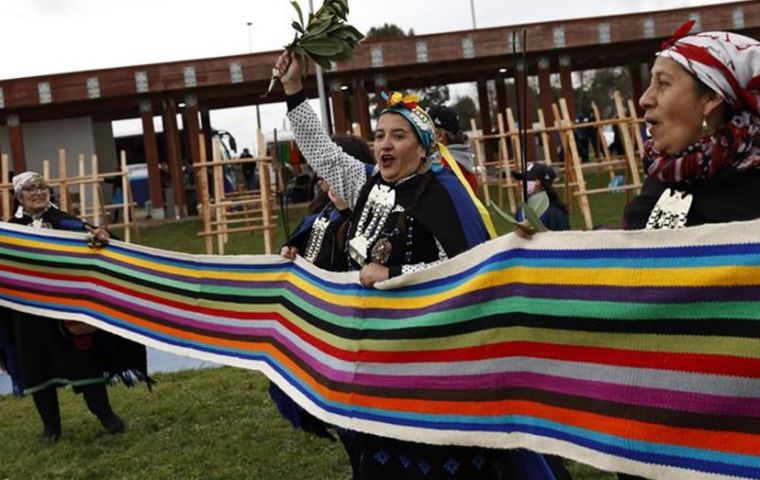MercoPress. South Atlantic News Agency
Mapuche women deliver longest weaving in the world
 Mapuche weavers from different parts of Chile and also from Argentina took part in the project
Mapuche weavers from different parts of Chile and also from Argentina took part in the project A total of 426 Mapuche women who were summoned a year ago for the task have come up with a loom almost 1 kilometer long to promote a Weltanschauung in which Chile's most numerous indigenous community is represented.
With that goal in mind, the undertaking by the Chilka Foundation on the coast of the southern commune of Puerto Saavedra largely surpassed the record held until now by China, with a weaving of 276.41 square meters.
“We want this work to travel around the world. We want it to travel, to establish itself in territories, and to speak for our weavers,” said Chilka Foundation President Ariel Traipi.
“We want to make visible not only the weaving but also the weaver in her context. We want to highlight the cultural landscapes, practices, and rituals. All of this is a journey, an immersion into Mapuche culture. We are thrilled by this triumph, which crowns us as the first indigenous people in the southern hemisphere to set a world record,” added the leader of the organization that seeks to promote Mapuche development in southern Chile.
Patricia Huinca, from Nueva Imperial, has been weaving for more than 25 years and is one of the coordinators of the more than 400 weavers who are participating in this milestone. “For me, it is a great emotion, a great joy. Today is for us the most wonderful day we have had as weavers because we have always been weaving inside our house, locked up. Nobody knew about our activity, about our weaving. But today we can say that we are going to make it known to the world,” she said.
“We have always been united, and this loom speaks of that, of union and peace,” she added.
Constanza Cea, executive director of Imagen de Chile, valued this “record that shows how, from our roots, Chile is creating a future. Our native peoples are positioning themselves internationally through culture, with this ancestral tradition that has been passed down from generation to generation. In addition, the Chilka Foundation carries the Chile brand, a key to give value to the origin of our country.”
Mapuche weavers from different parts of the country participated in the making of this loom, from the Coquimbo region in the north to the Los Lagos region in the south, and some of them even crossed the border from Argentina.
Although 90% of the participants already had some knowledge of traditional Mapuche “witxal” weaving, the Mapuche Ngüren School of Art and Crafts was created as part of the project. The material used to make the loom consisted of a ton of Dohne Merino sheep's wool from Tierra del Fuego, which was washed and dyed by the cooperative of artisans from the Puren community. The colors are those basic to the Mapuche culture, representing values ranging from Che Troki Wün (respect for the person) to Manelüwün (pledge of trust).
(Source: ANSA)




Top Comments
Disclaimer & comment rulesCommenting for this story is now closed.
If you have a Facebook account, become a fan and comment on our Facebook Page!